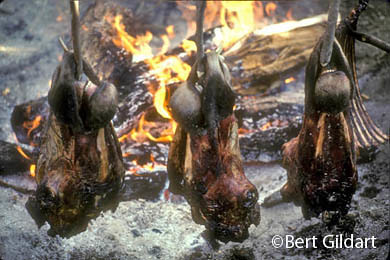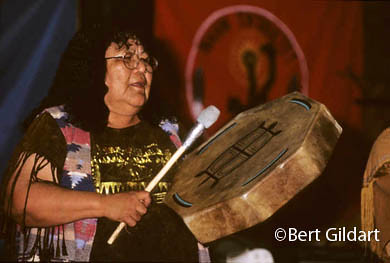Role of Sarah James in Protecting Arctic Refuge Prompts Another Prestigious Award
©Bert Gildart: Earlier this month, Sarah James of Arctic Village, Alaska, was inducted into the Woman’s Hall of Fame for her role in Environmental Activism. Janie and I met Sarah in 1991 and since that time have followed her in various ways. We greatly admire her.
Sarah has visited us in Montana, and I have covered her many achievements for a number of publications, to include the Christian Science Monitor. The story is part of the Gwich’in Indian Page in my website, and just as the Gwich’in Steering Committee provides a link to the write up on my site, so I, too, am providing a link to that story (Power of One). Read it and you’ll learn much about Ms. James. But you’ll also learn that there are two points of view regarding the refuge: One is the view point of oil companies, the other of scientifically trained biologists with advanced degrees.
ARCTIC REFUGE
Our memories with Sarah are many and include several nights around a campfire dozens of miles up the Chandalar River out of Arctic Village. It was September the week of our first of many visits, and Arctic nights were returning. Typically, we may have been roasting caribou heads over a fire, a Gwich’in Indian delicacy. Northern lights blazed, and we visited with her about the Porcupine Caribou herd and the Arctic National Wildlife Refuge.
During the evening Sarah recalled for us the importance of the caribou to her people, telling us about times in the not-so-distant past when caribou detoured around her village. “Those were not good time,” she had said.
Sarah said she hopes oil companies will not subvert the continuous needs of the Gwich’in for the caribou. She said she hopes Congress will one day recognize the beauty of the refuge and establish it as Wilderness. Having actually hiked the entire length of the refuge, which required over a month, Janie and I concur. We believe the beauty of this far flung land in the Arctic is beyond compare.
What follows is a news release about Sarah James provided me by the Gwich’in Steering Committee. Read it and you’ll learn a little about commitment. Link to my story as noted above and you’ll learn a little more about “The Power of One,” and the formative conditions in a hostile land that helped shape her and her beliefs.
NEWS RELEASE
Sarah James, as board chair and a spokesperson for the Gwich’in Steering Committee, has educated Alaskans, other Americans, Congress and peoples from around the world about the Gwich’in Nation, the Porcupine Caribou Herd and the importance of protecting “the Sacred Place where Life Begins” from oil exploration and drilling.
The goal of the Gwich’in is to permanently protect the coastal plain caving and nursing grounds of the caribou in the Arctic National Wildlife Refuge as wilderness. Raised in Alaska’s far north in a traditional lifestyle, she did not begin speaking English until she was about 13 years old. Living in the small community of Arctic Village, she has traveled widely, from Washington, D.C. to foreign countries, speaking out for the rights of indigenous peoples through grassroots activism.
In recognition of her leadership, she has received many awards. In 993, Sarah received the Alston Bannerman Fellowship award. In 2001, she received a Ford Foundation “Leadership for a Changing World” grant given to “outstanding but little known leaders”. She, along with the late Jonathon Solomon, Sr. and Norma Kassi, received the Goldman Environmental Prize for “grassroots environmentalists” in 2002. She also received the 2002 National Conservation Land Trust award. In 2004, she was the recipient of the 2004 “Ecotrust Award for Indigenous Leadership” and she received the 2006 Alaska Conservation Foundation Celia Hunter Award. Sarah is very thankful for the support of the Gwich’in National, her community, her son and her family. She credits the hard work of the Gwich’in and other people throughout the United States and the world as having contributed greatly to her successful efforts.
She was taught by her mother that there has to be a mutual respect between men and women for a healthy life. The impetus for her activism and the strength of her convictions may be best summarized in her own words, spoken in 2006: “This is my way of life. We are born with this way of life and we will die with it. It never occurred to me that something had to wake me up to do this. Nothing magic happened to me. Our life depends on it. It’s about survival; it’s something that we have to protect in order to survive. It’s our responsibility. It’s the environment we live in. We believe everything is related”.
________________________________________



